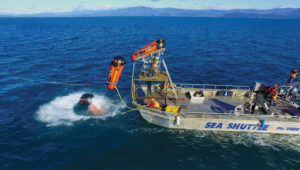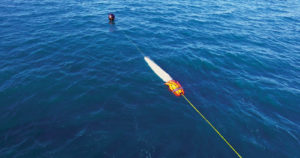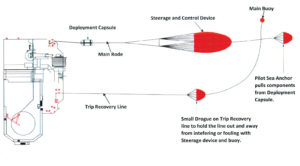Redesigned nylon para sea anchor provides unmatched strength and support for a new oil vessel.

Fabric’s wide-ranging aquatic capabilities are often observed above water in the form of sails, for example, or inflatable and flexible boating structures. When put to work beneath the surface, dependence on its strength is just as—if not more—critical, succeeding only after the material has passed rigorous tests carried out by a master of the craft.
When it comes to steerage and control systems, Coppins Sea Anchors Ltd. offers the needed expertise. The Motueka, New Zealand-based family business has been designing and manufacturing award-winning para sea anchors for more than 40 years. Though experienced in developing steerage systems for ships up to nearly 150 feet in diameter, Bill Coppins, managing director, and his team were recently presented a considerable challenge by an international oil company. The requested control system was for a brand-new vessel measuring 86 feet long and 170 feet wide, with gross tonnage of more than 100,000 tons.
IN CASE OF EMERGENCY
Working to extend the life of deep-water oil fields west of the Shetland Islands and generate additional production from nearby fields, the client replaced its existing floating, production, storage and offloading vessel (FPSO). The new ship

testing at various facilities at sea that
offer tough conditions. For this client,
Coppins tested seven scaled-down
prototypes and performed nearly
30 load tests on the fabric used.
featured a moon pool—a large area that provides direct access to the sea below—in its hull, into which numerous oil wells can be connected. Not without risk, this feature can severely affect the lateral stability of the FPSO if under tow, endangering the vessel and crew as well as the environment.
Structures called breakers are fitted at the vessel’s rear to generate drag and minimize such risks in extreme conditions. However, in the case of an accident or heavy storm, these can be lost or damaged, resulting in loss of control and efficiency. This is where an emergency steerage and control system comes into play—to control yaw motions, provide stability and make the tow manageable. Similar to a parachute when deployed, it turns a drifting vessel into the wind to reduce drift rate, prevent rolling and create a more stable platform for the crew to attempt to repair an equipment failure or safely wait for a towing vessel to arrive on scene.
The system comprises several elements, including an electronic release system; a fabric steering device; multiple ropes, with a main one that acts as the towing part of the entire device; a deployment capsule to hold most of the rope as well as the dragging device; a trip recovery line designed to trip the anchor so it can be recovered to use again; and a pilot sea anchor that pulls the components from the capsule.
TESTING TRIUMPH

The oil company first approached Coppins in 2013 with a design it developed for a feasibility study, but it didn’t circle back again until late spring of 2015. “By then we had tested a new design that would out-perform any such system previously developed,” Coppins recalls. “We had to show it was more stable than their original design, and this took a little bit of proving.” Adding to this challenge, the client wanted the system on the boat by December 2015—a time window that was closing fast.
To prove the utmost effectiveness, Coppins’s rigorous research and development process is broken into five stages: concept design; proof of concept; material design and testing; scale-up testing and refinement; and large-scale break load testing. Testing is completed in various facilities at sea, offering “the toughest conditions imaginable.”
The base of the Coppins Sea Anchor’s unique technology is its understanding of water hydrodynamics and the currents and forces created by a canopy dragged through the water. This is incorporated into the design of its systems to ensure the hydrodynamics create maximum drag force. The key is in the shape of the sea anchor, as it directs water movement, creating pressure in front and eddies on the back side of the anchor. Coppins compares the way its anchors create maximum drag to the way an airplane wing creates maximum lift.
Extensive testing of the new anchor design included several different shapes, with some featuring a skirt on the front and others with fins. Data and videos of the tests of seven scaled-down prototypes were sent to the client, helping to build trust and provide evidence. The winning design is “very much like a passion fruit,” Coppins says, “not exactly like a parachute.” When deployed, the component has a 27-foot diameter. Its conical shape—a deviation from the client’s initial request—greatly increased stability and efficiency in tests, decreasing lateral movement from 20 to 45 degrees, as initially requested, to only 2.5 degrees. A more conventional shape would not have provided this much control.
SUPERIOR STRENGTH
This particular FPSO needed a system that could control it in winds of up to force 11 on the Beaufort scale (approximately 64–72 mph) as it traveled from Asia to the North Sea. Because its massive weight and bulk would rely on less than one ton of fabric, it required a special, stronger fabric above and beyond the eight-plus different materials the company typically uses. “Some combine weight and strength or reduce weight while getting maximum strength. This is sheer strength,” Coppins says.
Coppins has undergone worldwide searches for the strongest rope, fabric, webbing and thread, workingwithaselectfewinternational suppliers. Forthisproject, thecompanyworked withamanufacturertodevelopacustomized nylon material in which warp and weft were almost equal under stress.“ The nylon’s weight wasn’taproblem, butstrengthwas. Wehadto understand how to design it to take as much loading as we could off of the actual fabric,” Coppins explains, noting that his company ran nearly 30 load tests on it before using just over 290 square meters to manufacture the anchor. Anotherbenefitofusingfabricisthat it naturally becomes compact, which is easier to stow away.
SHAPING THE FUTURE
After receiving the client’s approval, 11 weeks remained for both the manufacture and installation on the FPSO prior to the vessel’s departure. Once the system was ready for installation, it was air freighted to the client’s location in Korea, where Coppins employees spent four days training crew members on deployment instructions and safety issues. “Basic prep work is getting the ropes on deck and keeping the trip line away from the main rope so there is no tangling,” Coppins explains. When deployed, the capsule “slides into the sea similar to what lifeboats do,” he continues. “Everything is pulled from the capsule, and the anchor inflates. For recovery, they just lead off the main line and trip recover line, which turns the anchor around and collects it.”
Coppins believes the unique shape of this anchor will have wider use, noting that applications are now being actively pursued. “We believe that many more will benefit from this bold new design in the future,” he predicts.
Holly Eamon is an editor and writer based in Minneapolis, Minn.
 TEXTILES.ORG
TEXTILES.ORG


